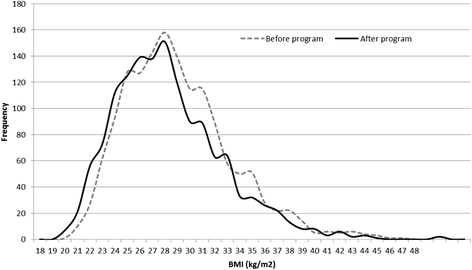Translational research: are community-based child obesity treatment programs scalable?
- PMID: 26169687
- PMCID: PMC4499906
- DOI: 10.1186/s12889-015-2031-8
Translational research: are community-based child obesity treatment programs scalable?
Abstract
Background: Community-based obesity treatment programs have become an important response to address child obesity; however the majority of these programs are small, efficacy trials, few are translated into real-world situations (i.e., dissemination trials). Here we report the short-term impact of a scaled-up, community-based obesity treatment program on children's weight and weight-related behaviours disseminated under real world conditions.
Methods: Children age 6-15 years with a body mass index (BMI) ≥ 85th percentile with no co-morbidities, and their parents/carers participated in a twice weekly, 10-week after-school child obesity treatment program between 2009 and 2012. Outcome information included measures of weight and weight-related behaviours. Analyses were adjusted for clustering and socio-demographic variables.
Results: Overall, 2,812 children participated (54.2% girls; M(age) 10.1 (2.0) years; M(attaendance) 12.9 (5.9) sessions). Beneficial changes among all children included BMI (-0.65 kg/m(2)), BMI-z-score (-0.11), waist circumference (-1.8 cm), and WtHtr (-0.02); self-esteem (+2.7 units), physical activity (+1.2 days/week), screen time (-4.8 h/week), and unhealthy foods index (-2.4 units) (all p < 0.001). Children who completed ≥ 75% of the program were more likely to have beneficial changes in BMI, self-esteem and diet (sugar sweetened beverages, lollies/chocolate, hot chips and takeaways) compared with children completing <75% of the program.
Conclusions: This is one of the few studies to report outcomes of a government-funded, program at scale in a real-world setting, and shows that investment in a community-based child obesity treatment program holds potential to produce short-term changes in weight and weight-related behaviours. The findings support government investment in this health priority area, and demonstrate that community-based models of child obesity treatment are a promising adjunctive intervention to health service provision at all levels of care.
Figures
References
-
- Australian Institute of Health and Welfare . Australia’s Health 2014. Canberra: AIHW; 2014.
-
- Wake M, Baur LA, Gerner B, Gibbons K, Gold L, Gunn J, Levickis P, McCallum Z, Naughton G, Sanci L, et al. Outcomes and costs of primary care surveillance and intervention for overweight or obese children: the LEAP 2 randomised controlled trial. BMJ. 2009;339:b3308. doi: 10.1136/bmj.b3308. - DOI - PMC - PubMed
-
- Oude LH, Baur L, Jansen H, Shrewsbury VA, O’Malley C, Stolk RP, Summerbell CD. Interventions for treating obesity in children. Cochrane Database Syst Rev. 2009;1:CD001872. - PubMed
-
- Nutbeam D, Bauman AE. Evaluation in a nutshell: a practical guide to the evaluation of health promotion programs, vol. 2nd. North Ryde: McGraw-Hill Australia Pty Ltd; 2006.
Publication types
MeSH terms
LinkOut - more resources
Full Text Sources
Other Literature Sources
Medical


